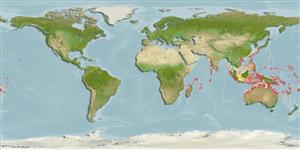Common names from other countries
>
Eupercaria/misc (Various families in series Eupercaria) >
Labridae (Wrasses) > Corinae
Etymology: Pseudocoris: Greek, pseudes = false + Greek, kore = pupil (Ref. 45335).
Environment: milieu / climate zone / depth range / distribution range
Ecologia
marinhas associadas(os) a recifes; intervalo de profundidade 5 - 90 m (Ref. 90102). Tropical; 32°N - 30°S, 57°E - 178°W
Western Pacific: Micronesia to Samoa; reported from Rowley Shoals (Ref. 1602) and Kermadec Islands (Ref. 8879). Reported to extend to the Indian Ocean: Maldives (Ref. 11303), Mauritius and East Africa (Ref. 9710), Christmas Island (Ref. 30874).
Tamanho / Peso / Idade
Maturity: Lm ? range ? - ? cm
Max length : 16.0 cm TL macho/indeterminado; (Ref. 48636)
Descrição breve
Chaves de identificação | Morfologia | Morfometria
Espinhos dorsais (total) : 9; Raios dorsais moles (total) : 12; Espinhos anais: 3; Raios anais moles: 12. Dorsal half of body dark, or without distinct markings. Anteriormost pair of teeth on lower jaw distinctly larger than other teeth. First dorsal spin in males elongated. Caudal fin emarginate or truncate (Ref. 43239).
Found up to a depth of at least 25 m in lagoon, channel and seaward reefs (Ref. 9710). Often on open sand flats with large remote bommies in depths of about 20 m. Juveniles congregate on reefs, usually in depths of 10-20 m feeding on mysids (Ref. 48636). Aggregates (with females outnumbering the males) along upper edges of coral slopes to feed on zooplankton (Ref. 9710, 48636). Maximum depth reported taken from Ref. 128797.
Life cycle and mating behavior
Maturities | Reprodução | Spawnings | Egg(s) | Fecundities | Larvas
Oviparous, distinct pairing during breeding (Ref. 205).
Randall, J.E., G.R. Allen and R.C. Steene, 1990. Fishes of the Great Barrier Reef and Coral Sea. University of Hawaii Press, Honolulu, Hawaii. 506 p. (Ref. 2334)
Categoria na Lista Vermelha da IUCN (Ref. 130435)
CITES (Ref. 128078)
Not Evaluated
Ameaça para o homem
Harmless
Utilização humana
Pescarias: sem interesse; Aquário: Espécies comerciais
Ferramentas
Relatórios especiais
Descarregue XML
Fontes da internet
Estimates based on models
Preferred temperature (Ref.
115969): 24.6 - 29.3, mean 28.4 (based on 1811 cells).
Phylogenetic diversity index (Ref.
82804): PD
50 = 0.5020 [Uniqueness, from 0.5 = low to 2.0 = high].
Bayesian length-weight: a=0.00490 (0.00204 - 0.01176), b=3.11 (2.90 - 3.32), in cm Total Length, based on LWR estimates for this (Sub)family-body shape (Ref.
93245).
Nível Trófico (Ref.
69278): 3.4 ±0.45 se; based on food items.
Resiliência (Ref.
120179): Elevada, tempo mínimo de duplicação da população menor que 15 meses (Preliminary K or Fecundity.).
Fishing Vulnerability (Ref.
59153): Low vulnerability (10 of 100).
